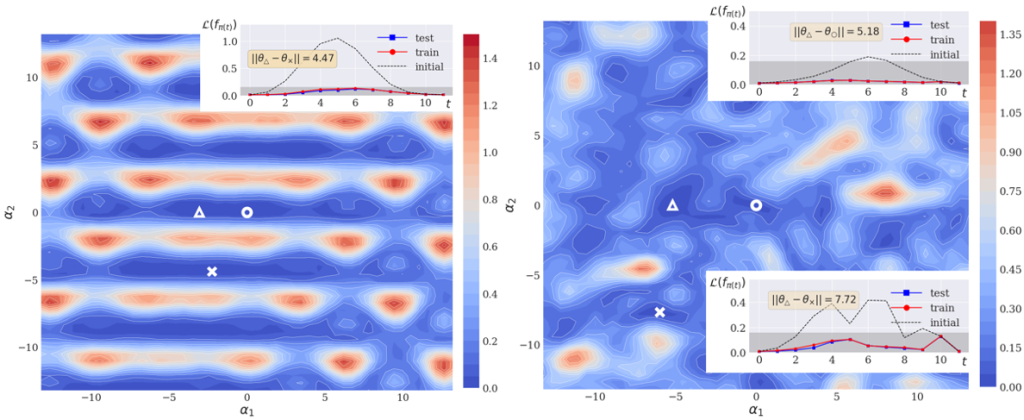
Achievement:
Researchers from Oak Ridge National Laboratory (ORNL) demonstrated that mode connectivity exists in the loss landscape of parameterized quantum circuits. Using methods developed for analyzing the landscape of classical deep neural networks, the team developed visualization and analysis tools for quantum circuits used in near-term quantum machine learning applications. Two studies have been executed that train several hundred quantum circuits, in order to implement a brute force exploration of the loss landscape. This approach tests different elements of quantum circuit design and training, and can identify multiple minima in the landscape. The first study trained quantum regression models, the team compared the role of different entangling gate topologies and classical optimizers on the performance of each regressor in fitting a low order polynomial function. The second study trained quantum circuit Born machines to prepare distributions sampled from highly entangled quantum states (GHZ states) and compared the effect of different circuit parameterizations and designs on overall performance.
Low-dimensional representations of the loss landscape (training landscape) provided insight into where and how regions of low loss are located, and which optimizers were best at effectively navigating the landscapes. Many low loss regions appeared as isolated minima in the landscapes, but larger features such as ravines could also be found. Initial studies have supported that the existence of ravines could be related to dropout stability in quantum circuit training. The team modified and adapted the nudged elastic band algorithm, which was developed for classical potential landscapes, to the quantum circuit landscapes. By deforming a naïve straight line cut in the landscape, the team showed that between several minima it was possible to find connecting paths of low loss. These results indicate that the solution spaces for quantum circuit models is more complex that finding a single global minima. The difficulty of finding these low loss paths is affected by the circuit size (number of qubits), and circuit design.
Significance and Impact:
There is significant interest in quantifying and understanding the trainability of quantum circuit models for machine learning applications. However, most analysis is done in the context of finding global minima in the optimization landscape, or focused on algorithms which rely on a priori knowledge of a physical Hamiltonian. Additionally, while other studies have relied on low dimensional representations of the loss landscapes, these visualizations are made by varying single parameters while keeping the remaining model parameters fixed. With gradient-based training, all parameters in the circuit are varied at the same time—the visualization methods developed by the ORNL team vary all parameters in a model, this provides an in-depth characterization of how the landscape is structured. By establishing that regions of low loss can be connected by non-trivial paths of low loss, this work shows that the landscape associated with quantum circuit training for machine learning applications has complex structures.
Research Details
- The quantum circuit regression models were constructed and trained using the PennyLane library. Two different circuit designs were used, and 3 different gradient-based optimizers (stochastic gradient descent, Adam, quantum natural gradient) were used with minibatch training.
- The quantum circuit Born machines were constructed and trained using the Qiskit library. Two different circuit designs, two different parameterizations and one gradient-based optimizer was used.
- Each regression model was trained for 100 optimization steps, using multiple mini-batches and initializations. Each quantum circuit Born machine was trained for 50 optimization steps using different initializations.
- Overall this study generated hundreds of trained models for each combination of circuit depth, design and optimizer which provided a brute force exploration of the loss landscape
- Visualization methods and the nudged elastic band algorithm, which have been used in the classical machine learning literature were adapted for quantum circuit applications.
- Mode connectivity was observed in both training landscapes
Facility: The simulations and research were conducted at ORNL.
Sponsor/Funding: DOE ASCR
PI and affiliation:
Raphael C. Pooser Quantum Sensing Group, Computational Sciences and Engineering Division, ORNL
Team:
Kathleen E. Hamilton (ORNL), Emily Lynn (SULI), Vicente Leyton-Ortega (ORNL), Swarnadeep Majumder (Duke University), Raphael C. Pooser (ORNL)
Citation and DOI:
- K. E. Hamilton, E. Lynn, R. C. Pooser. Mode connectivity in the loss landscape of parameterized quantum circuits. Submitted to Quantum Machine Intelligence – under review.
- K. E. Hamilton, E. Lynn, V. Leyton-Ortega, S. Majumder, R. C. Pooser. Mode connectivity in the QCBM loss landscape: ICCAD Special Session Paper. Invited paper to be published in the proceedings of the ICCAD 2020 Conference.
Summary:
Quantum machine learning is a rapidly advancing field, as today’s quantum computers become larger and capable of running complex circuits. This presents the opportunity to train large quantum circuit models for machine learning applications. However, scalable, and efficient methods of training have yet to be established. Understanding how the solution space of a quantum model is structured, and understanding how circuit design influences the training landscape, will facilitate the development of better training methods and better model designs. By establishing that mode connectivity exists in the quantum circuit landscape, these results will motivate additional study into the connection between circuit design and trainability.



